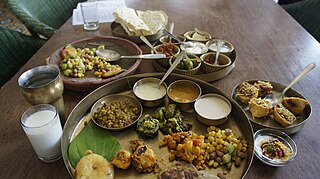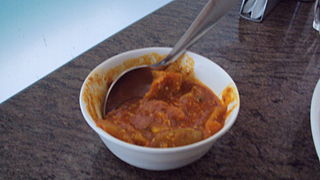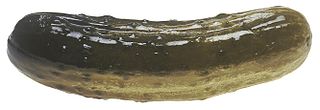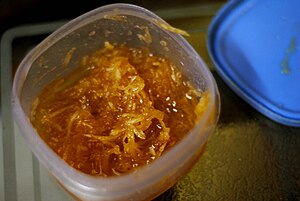
A chutney is a spread typically associated with cuisines of the Indian subcontinent. Chutneys are made in a wide variety of forms, such as a tomato relish, a ground peanut garnish, yogurt or curd, cucumber, spicy coconut, spicy onion or mint dipping sauce.
Indian cuisine consists of a variety of regional and traditional cuisines native to India. Given the diversity in soil, climate, culture, ethnic groups, and occupations, these cuisines vary substantially and use locally available spices, herbs, vegetables, and fruits.

Mixed pickles are pickles made from a variety of vegetables mixed in the same pickling process. Mixed pickles are eaten much like other pickles: in small amounts to add flavor and to accent a meal. Mixed pickles appear in many different world cuisines.

Raita is a side dish in Indian cuisine made of dahi together with raw or cooked vegetables, more seldom fruit, or in the case of boondi raita, with fried droplets of batter made from besan.

Rajasthani cuisine is the cuisine of the Rajasthan state in North West India. It was influenced by various factors like the warlike lifestyles of its inhabitants, the availability of ingredients in an arid region and by Hindu temple traditions of sampradayas like Pushtimarg and Ramanandi. Food that could last for several days and could be eaten without heating was preferred. Scarcity of water and fresh green vegetables have all had their effect on the cooking. Signature Rajasthani dishes include Dal Baati Churma, Panchratna Dal, Papad ro Saag, Ker Sangri, Gatte ro Saag. It is also known for its snacks like Bikaneri bhujia, Mirchi bada and Kanda kachauri. Other famous dishes include Dal Baati, malaidar special lassi (lassi) and Lashun ki chutney, Mawa lassi from Jodhpur, Alwar ka mawa, Malpauas from Pushkar and rasgulla from Bikaner, "paniya"and "gheriya" from Mewar. Originating for the Marwar region of the state is the concept Marwari Bhojnalaya, or vegetarian restaurants, today found in many parts of India, which offer vegetarian food of the Marwari people. The history also has its effect on the diet as the Rajputs preferred majorly a non-vegetarian diet while the Brahmin, Jains, and others preferred a vegetarian diet. So, the state has a myriad of both types of delicacies.

Pickling is the process of preserving or extending the shelf life of food by either anaerobic fermentation in brine or immersion in vinegar. The pickling procedure typically affects the food's texture and flavor. The resulting food is called a pickle, or, if named, the name is prefaced with the word, 'pickled'. Foods that are pickled include vegetables, fruits, mushrooms, meats, fish, dairy and eggs.

Curd rice, also called yogurt rice, is a dish originating from India. The word "curd" in Indian English refers to unsweetened probiotic yogurt. It is most popular in the South Indian states of Tamil Nadu, Kerala, Karnataka, Telangana and Andhra Pradesh; and also in West Indian states of Rajasthan, Gujarat and Maharashtra. In the state of Rajasthan it is known as Auliya, in Gujarat it is known as Ghens and in Maharashtra it is known as dahi bhat. In the state of Tamil Nadu it is called thayir saadam or soru, in Kerala it is called tayire chōre and in Telangana and Andhra Pradesh it is called perugannam/daddojanam. In Karnataka, it is called mosaranna. The dish is a staple of traditional cuisine, with the untempered version present at the end of almost every Indian meal during summers. In the states of Rajasthan and Gujarat, curd rice varieties Auliya and Ghens are prepared on Shitala Saptami and Randhan Chhath festival. The tempered version is often served during formal occasions and also offered as prasadam to devotees in temples.
Maharashtrian or Marathicuisine is the cuisine of the Marathi people from the Indian state of Maharashtra. It has distinctive attributes, while sharing much with other Indian cuisines. Traditionally, Maharashtrians have considered their food to be more austere than others.

Gujarati cuisine is the cuisine of the Indian state of Gujarat. The typical Gujarati thali consists of rotli, dal or curry, rice, and shaak. The thali will also include preparations made from pulses or whole beans such as moong, black eyed beans etc., a snack item (farsaan) like dhokla, pathra, samosa, fafda, etc. and a sweet (mishthaan) like mohanthal, jalebi, sevaiya etc.

South Asian pickle is a pickled food made from a variety of vegetables and fruits preserved in brine, vinegar, edible oils, and various South Asian spices. The pickles are popular across South Asia, with many regional variants, natively known as Lonache, Avalehikā, Uppinakaayi, Pachadi or Noncha, Achaar, Athāṇu or Athāṇo or Athāna, Khaṭāī or Khaṭāin, Sandhan or Sendhan or Sāṇdhāṇo, Kasundi, or oorugaai.

Kadhi, or karhi, is a popular dish mainly consumed in South Asia. It consists of a thick gravy or soup based on gram flour, and it may contain vegetable fritters called pakora, which include dahi (yogurt) for a sour taste. It is often eaten with cooked rice or roti. Varieties of kadhi include those from Rajasthan, Maharashtra, Gujarat, Punjab, and Sindh, all of which are located in present-day India and Pakistan.

A pickled cucumber – commonly known as a pickle in the United States and Canada and traditionally a gherkin in Britain, Ireland, South Africa, Australia, and New Zealand – is a usually small or miniature cucumber that has been pickled in a brine, vinegar, or other solution and left to ferment. The fermentation process is executed either by immersing the cucumbers in an acidic solution or through souring by lacto-fermentation. Pickled cucumbers are often part of mixed pickles.

A mango pickle is a variety of pickle prepared using mango. It is very popular in South and Southeast Asia. These sour/spicy pickles are also available commercially.

Andhra cuisine, culturally known as Telugu cuisine, is a cuisine of India native to the state of Andhra Pradesh. It is generally known for its tangy, hot, and spicy taste.

Acar is a type of vegetable pickle of Maritime Southeast Asia, most prevalent in Indonesia, Malaysia, Singapore and Brunei. It is a localised version of Indian achar. It is known as atjar in Dutch cuisine, derived from Indonesian acar. Acar is usually prepared in bulk as it may easily be stored in a well-sealed glass jar in refrigerator for a week, and served as a condiment for any meals.
Fruit ketchup is a condiment prepared using fruit as a primary ingredient. Various fruits are used in its preparation, and it is also used as a spread and marinade, among other uses. Banana ketchup is a type of fruit ketchup that is common in the Philippines. Some companies mass-produce fruit ketchup, such as Philippines-based Jufran, and Chups, a small company based in Washington, D.C., United States.

Thepla is a soft Indian flatbread typical of Gujarati cuisine While extremely popular across Gujarat, it is especially common amongst the Jain community.















